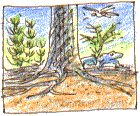 |
Slate and SandstoneSunday, 31st March 2002, West Yorkshire |
![]()
![]()
![]()
![]() This Month
Rocks
History
Workshop
Links
Home Page
This Month
Rocks
History
Workshop
Links
Home Page
![]()
Sandstone
 The sandstone was laid down in a river delta some 300 million years ago. 'Britain' then lay close to the equator. Giant club mosses, giant horsetails and fern-like trees grew in dense tropical forests.
The sandstone was laid down in a river delta some 300 million years ago. 'Britain' then lay close to the equator. Giant club mosses, giant horsetails and fern-like trees grew in dense tropical forests. In contrast to the millstone grit of the central Pennines coal measures sandstone is typically made up of much smaller grains. Compared with the gritstone these grains are well sorted; there is far less variation in size.
In contrast to the millstone grit of the central Pennines coal measures sandstone is typically made up of much smaller grains. Compared with the gritstone these grains are well sorted; there is far less variation in size.The grit and sand were eroded from the Caledonian mountains to the north. The sand grains are held together by an iron-rich natural cement known as limonite.
Slate
 Slate doesn't occur locally in West Yorkshire (the nearest slaty rocks to us are in the heart of the Yorkshire Dales). It's older than the sandstone and was originally laid down as fine muddy sediment on the bed of a long-lost ocean, the Iapetus, a forerunner of the Atlantic some 400 to 500 million years ago. These sediments were caught up in a collision of continents as the Iapetus ocean closed. Pressure rather than heat changed the sediments. New platy minerals grew at right angles to the vice-like pressure.
Slate doesn't occur locally in West Yorkshire (the nearest slaty rocks to us are in the heart of the Yorkshire Dales). It's older than the sandstone and was originally laid down as fine muddy sediment on the bed of a long-lost ocean, the Iapetus, a forerunner of the Atlantic some 400 to 500 million years ago. These sediments were caught up in a collision of continents as the Iapetus ocean closed. Pressure rather than heat changed the sediments. New platy minerals grew at right angles to the vice-like pressure. In Yorkshire slate largely replaced local flagstones as a roofing material after the railway network arrived. Because of the expense they're only occasionally used today and for the average home composition tiles - in effect coloured concrete - are used.
In Yorkshire slate largely replaced local flagstones as a roofing material after the railway network arrived. Because of the expense they're only occasionally used today and for the average home composition tiles - in effect coloured concrete - are used.![]()
Richard Bell,
wildlife illustrator
E-mail; 'richard@willowisland.co.uk'
![]() Next page
Previous page
This day in 2000
This month
Nature Diary
Home Page
Next page
Previous page
This day in 2000
This month
Nature Diary
Home Page
![]()